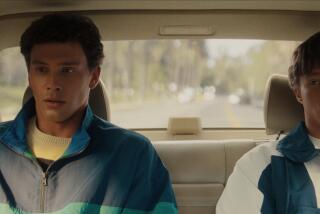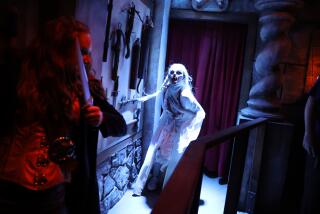It Has a Virgin and Bela Lugosi, but It’s Not ‘Dracula’
Bela Lugosi may have started as a classical actor in Hungary, but it didn’t take long for him to turn into a monster after his Hollywood arrival in the early 1930s.
As just about everybody knows, Lugosi became the Count in the 1931 version of “Dracula,” which has gone down as the quintessential vampire movie. There have been numerous Dracula incarnations since, but Lugosi’s is the one most people remember.
The problem is, Lugosi isn’t remembered for too much more. Oh, there are those bizarre (and sad) appearances in whacked-out Edward D. Wood flicks such as “Plan 9 From Outer Space” and “Glen or Glenda?” (more about these later), but his popular career almost seemed to stop with the release of “Dracula.”
Of course, there were several other films to follow that movie’s immense popularity. One of them, “Murders in the Rue Morgue,” which came out in 1932, will screen Friday as the last stop in the Newport Harbor Art Museum’s Halloween-inspired “Caligari and Co.” series.
It’s a curious picture, more chaotic than frightening. Lugosi plays Dr. Mirakle, a scientist with crackpot evolutionary theories, in this loose adaptation of Poe’s famous story. The mad doctor tries to mate his pet ape with a virgin, giving Lugosi an excuse to zoom over the fringe with his customary pop-eyed lustiness.
The film can’t be considered a success, not by any standards, but it’s interesting for various reasons.
Cinematically, “Murders in the Rue Morgue” provided John Huston with one of his first writing jobs. Some film historians credit the movie’s attempt at a fairly brainy core (Darwinian principles, of all things) and its sensationalistic texture directly to Huston.
Other than that, it’s most intriguing as a horror-flick footnote. Shortly after Lugosi’s success in “Dracula,” he was offered the monster role in “Frankenstein.” But Lugosi refused, thinking the character was beneath him. Besides, he didn’t want to wear all that makeup, something Boris Karloff had no problems with.
Karloff, another classically trained actor, went on to stardom with his portrayal, which Lugosi for years underestimated. Lugosi said Karloff brought little more than grunts and growls to his performance, which, as everybody else knew, was a superficial and probably spiteful appraisal. Lugosi instead chose “Murders in the Rue Morgue,” which was mildly popular but still swamped by “Frankenstein” at the box office.
Lugosi rebounded with “White Zombie” later in 1932. The story--about a Haitian sugar mill owner, Murder Legendre (Lugosi), who reduces labor costs by employing a zombie work force--was weird enough to satisfy Lugosi’s Gothic instincts. Realizing he needed to recover from “Murders in the Rue Morgue,” Lugosi took the reins from director Victor Halperin early in the shoot and made one of his better films.
Although he appeared in minor roles in a few good movies (“Ninotchka” with Greta Garbo in 1939 stands out), the string of mediocre to bad budget vehicles that came later were numerous, as Lugosi slowly slipped from the big-time. He eventually went on to revive “Dracula” on stage in cities across the country. Then he met up with Wood, the cheapo director whose banzai film adventures made the studios’ B movies look like million-dollar gems.
In “Glen or Glenda?” (1953), it’s hard to figure out what Lugosi’s role is. He opens the flick about a troubled transvestite by gabbing about the many mysteries of life; he’s surrounded by lab stuff, so he’s probably a scientist. His character pops up every now and then for no reason at all. Well, there was a reason--Wood thought Lugosi might still have box office appeal.
He felt the same way in 1959 with “Plan 9 From Outer Space,” a sci-fi disaster widely considered the worst movie ever made. In the few scenes Lugosi plays, he appears more ashen than any makeup could provide, and his acting is far more somnambulistic than that of the zombies who stumble through Wood’s lousy fog-and-brambles back-lot sets.
The picture marked Lugosi’s sad end in Hollywood. Lugosi, a drug addict, died two days into the shooting, and Wood had to replace him with a younger (and much taller) actor who covered his face with the sleeve of a schlocky Dracula costume.
More to Read
Only good movies
Get the Indie Focus newsletter, Mark Olsen's weekly guide to the world of cinema.
You may occasionally receive promotional content from the Los Angeles Times.










